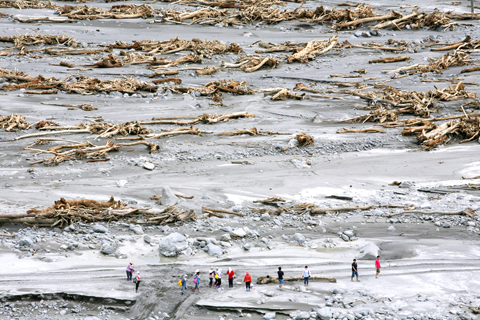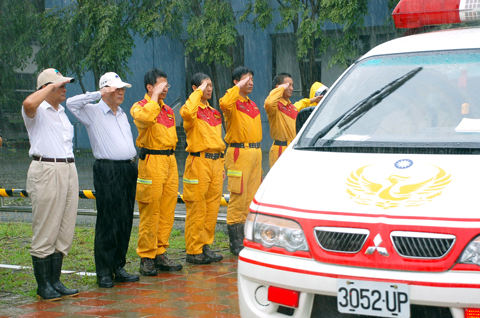With the clock ticking and many more people trapped in mountainous villages, rescuers continued their effort to find survivors.
Amid the stories of death and losses came the news of the rescue late on Tuesday night of some 700 survivors who had been reported missing — 200 people from Xiaolin Village (小林) in Kaohsiung County's Jiaxian Township (甲仙), 300 from Namasia Township's (那瑪夏) Minzu Village (民族) and 200 from Namasia's Minsheng Village (民生). Yesterday morning, 300 more survivors were found in Namasia's Minchuan Village (民權), 200 in Taoyuan Township's (桃源) Chinhe Village (勤和) and 70 more from Xiaolin.
“The village chief of Chinhe Village evacuated all 200-odd villagers from their homes to the village sports complex on Saturday,” Hu Jui-chou (胡瑞舟), director of political warfare at the Army Command Headquarters' 8th Army Corps, told a press conference.

PHOTO: LIU JONG, TAIPEI TIMES
“When they were found, the survivors were picking wild vegetables and were glad that the soldiers had found them earlier than they expected amidst the severe disaster,” he said.
Hu said the villagers were fine and had sufficient air-dropped food and water.
However, even with almost 300 survivors found, Xiaolin, the hardest hit village, which has been completely wiped out and lies buried under mudslides, still has more than 300 residents missing.

PHOTO: KUO CHING-HUI, TAIPEI TIMES
Army helicopters were ferrying survivors to safety in Cishan (旗山), the hardscrabble town in Kaohsiung County that is serving as a focal point for relief operations.
“So long as weather permits, the military aircraft will fly up to 136 sorties today to evacuate all stranded typhoon victims,” Hu said.
However, heavy rains were obstructing rescue operations and by early afternoon, only a few dozen flights had arrived at the makeshift landing zone at Cishan Junior High School.
People who have been evacuated to Jiaxian's Cishan Junior High School bawled in despair and pleaded for the army to go into their village to save their families.
“Xiaolin Village is gone. People are still buried under the mud, please save them,” a survivor surnamed Huang (黃) said.
Another survivor, Pan Hsiu-min (潘秀敏) was near physical collapse when she learned that none of the 40 members in her extended family had been found.
“They are my family, somebody go in and save them. Where is family?” Pan said.
Some anxious and angry survivors decried the government's delayed reaction and slow progress in rescuing victims.
“We have a retarded government,” a banner said.
Luo Shun-chi, 36, who escaped from Xiaolin shortly after Sunday's mudslide, told The Associated Press he did not know how many of his fellow villagers were still alive.
He said that between 500 and 600 people were in Xiaolin at the time of the disaster — far fewer than the 1,300 people listed in the nation's population registry.
Luo said that whatever the death toll was in Xiaolin, he was never going back.
“The place is finished,” he said. “There is no way I could return.”
The Directorate General of Highways said yesterday its target was to have Provincial Highway No. 21 at Jiaxian Township opened today, which would allow rescuers easier access to victims in Xiaolin and Namasia villages.
In Taitung, a volunteer rescuer nearly drowned yesterday when he was trying to cross Taimali River (太麻里溪) to reach victims in Dawu Township (大武).
The rescue team tried to cross the river by hooking a rubber boat to a suspension rope. The raging torrent proved too much for the rope, which snapped. The boat then flipped, tossing the rescuer into the river. He was pulled from the river by his teammates and the boat was later recovered after it became caught in debris.
Meanwhile, residents of Shanmei Village (山美) remain trapped after the highway to Alishan was damaged by landslides.
Village representative An Li-hua (安麗花) said yesterday the village was short of drugs to treat flu and high blood pressure. It also needs fuel for its power generator. Some of the residents sent photographs via mobile phones to inform authorities of their situation.
Also in Chiayi, the military sent a rescue team to Taiho Village (太和) to search for villagers.
In Pingtung County, 350 people in five isolated villages were evacuated yesterday. The villages in Wutai Township had been cut off when all bridges and roads linking the mountainous area with the outside world were severely damaged.
Most of the villages were accessible only by narrow mountain roads that often cross or follow riverbeds. The roads and connecting bridges buckled under the pressure of floodwaters brought by Typhoon Morakot.
Meanwhile, the bodies of the three crewmembers of a UH-1H helicopter that crashed at 3:32pm on Tuesday in the Yila Valley in Wutai Township while on a rescue mission, were found yesterday morning, the National Airborne Services Corps (NASC) said.
Captain Chen Chung-hsien (陳崇賢) of the NASC confirmed the deceased were 42-year-old pilot Chang Shun-fa (張順發), 47-year-old copilot Wang Tsung-li (王宗立) and 43-year-old crew chief Huang Mei-chih (黃鎂智). He said the cause of the accident still had to be investigated.
Thirty Rukai Aborigines in the village performed a prayer in Rukai, led by a priest, Wang Chao-shien (王朝賢), as the rescue team retrieved the bodies and flew them to Neipu Township (內埔), Pingtung County.
Minister of the Interior Liao Liou-yi (廖了以) and Pingtung County Commissioner Tsao Chi-hung (曹啟鴻) were on hand to receive the bodies and extend their condolences to the officers' families.
Huang's father said the family had stayed up all night, and that Huang's mother had been praying to Buddha since their son went missing.
“But this is as good, it is his fate. I am proud of him, really. He died serving the public,” the father said.
Chang, Wang and Huang's families will receive up to NT$10 million (US$303,700) each in compensation, Chen said.
Seven UH-1H choppers have been deployed for the rescue and relief mission since Saturday, Chen said.
However, “all 20 of the military's UH-1H helicopters have been grounded since the accident. Instead, we are dispatching five AS-365, two B-234, and one S-76 chopper to carry out the rest of the missions,” he said.
As of 9pm, the Central Emergency Operation Center listed 103 people as confirmed dead, 61 missing and 45 injured. The death toll is expected to rise as hundreds of villagers in the south remain unaccounted for.
ADDITIONAL REPORTING BY SHELLEY SHAN AND SHIH HSIU-CHUAN

The US government has signed defense cooperation agreements with Japan and the Philippines to boost the deterrence capabilities of countries in the first island chain, a report by the National Security Bureau (NSB) showed. The main countries on the first island chain include the two nations and Taiwan. The bureau is to present the report at a meeting of the legislature’s Foreign Affairs and National Defense Committee tomorrow. The US military has deployed Typhon missile systems to Japan’s Yamaguchi Prefecture and Zambales province in the Philippines during their joint military exercises. It has also installed NMESIS anti-ship systems in Japan’s Okinawa

TRAGEDY STRIKES TAIPEI: The suspect died after falling off a building after he threw smoke grenades into Taipei Main Station and went on a killing spree in Zhongshan A 27-year-old suspect allegedly threw smoke grenades in Taipei Main Station and then proceeded to Zhongshan MRT Station in a random killing spree that resulted in the death of the suspect and two other civilians, and seven injured, including one in critical condition, as of press time last night. The suspect, identified as a man surnamed Chang Wen (張文), allegedly began the attack at Taipei Main Station, the Taipei Fire Department said, adding that it received a report at 5:24pm that smoke grenades had been thrown in the station. One man in his 50s was rushed to hospital after a cardiac arrest

‘WIN-WIN’: The Philippines, and central and eastern European countries are important potential drone cooperation partners, Minister of Foreign Affairs Lin Chia-lung said Minister of Foreign Affairs Lin Chia-lung (林佳龍) in an interview published yesterday confirmed that there are joint ventures between Taiwan and Poland in the drone industry. Lin made the remark in an exclusive interview with the Chinese-language Liberty Times (the Taipei Times’ sister paper). The government-backed Taiwan Excellence Drone International Business Opportunities Alliance and the Polish Chamber of Unmanned Systems on Wednesday last week signed a memorandum of understanding in Poland to develop a “non-China” supply chain for drones and work together on key technologies. Asked if Taiwan prioritized Poland among central and eastern European countries in drone collaboration, Lin

ON ALERT: Taiwan’s partners would issue warnings if China attempted to use Interpol to target Taiwanese, and the global body has mechanisms to prevent it, an official said China has stationed two to four people specializing in Taiwan affairs at its embassies in several democratic countries to monitor and harass Taiwanese, actions that the host nations would not tolerate, National Security Bureau (NSB) Director-General Tsai Ming-yen (蔡明彥) said yesterday. Tsai made the comments at a meeting of the legislature’s Foreign Affairs and National Defense Committee, which asked him and Minister of National Defense Wellington Koo (顧立雄) to report on potential conflicts in the Taiwan Strait and military preparedness. Democratic Progressive Party (DPP) Legislator Michelle Lin (林楚茵) expressed concern that Beijing has posted personnel from China’s Taiwan Affairs Office to its